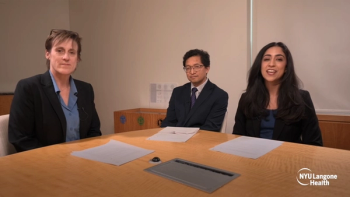
- Ophthalmology Times: February 1, 2021
- Volume 46
- Issue 2
When inspiration strikes...
An ophthalmologist’s thoughts while folding clothes.
As difficult as the pandemic has been for so many of us, one positive aspect for me has been more stay-at-home lab meetings over virtual platforms and thus more time to spend with my energetic 4-year-old daughter.
Now, mind you, I have survived rigorous training in some of the most intense environments and served as ocular trauma chief at Wilmer Eye Institute—but entertaining your daughter is legitimately much harder than working in the clinic, lab, or operating room.
As any stay-at-home parent will tell you, the primary daily goals of parenting are to A) have your child think that you are super cool, B) not upset your spouse, and C) fill the time to make it to bedtime unscathed. For clarity, the order of priority is C > B > A (but maybe sometimes B > C > A).
It turns out that one way to accomplish all of the above is to teach your child how to do chores.
For example, doing laundry can seem very mundane, but it is a lot more fun when you unload an entire basketful of warm, freshly tumbled clothes on top of your child’s head (especially in the middle of a cold Iowa winter).
Then you can show her how to fold some of her own pants, and look super capable (A, check!) while also making mom proud (B, check!).
We do not go anywhere anymore, but given how many outfit changes my daughter goes through in a day (from nighttime pajamas to day pajamas, and to various makeshift princess dresses using blankets and sheets), there is a lot of laundry to fold.
Related:
Readers of Ophthalmology Times® know there are many different clothes-folding techniques to employ—some are easy, some avoid creases in delicate areas, others are more roll than fold to save space, and some help clothes stand vertically in your drawer because it looks more organized and makes you happier that way (right, Marie Kondo?).
Of course, my precocious daughter mastered her technique of choice: the wad.
Children by definition are entropy incarnate, so given her earnest efforts, I smiled as she quickly built a stack of wadded clothes and moved on to more interesting tasks.
Refolding my daughter’s clothes provided ample time for musing—what is so complicated about folding, anyway?
Folding is, in fact, a vital art form for every living thing, and because I am an investigator working on cures for inherited eye diseases, dealing with the consequences of misfolding is my actual day job.
Our genetic code is encrypted within DNA, which has to be delicately unfolded and transcribed into strands of RNA, which then have to be translated to chains of amino acids, which then (depending on countless factors, including pH, temperature, molecular attractions, and the like) are folded into complex, 3-dimensional proteins, which in turn comprise cells, which comprise, well, us.
Related:
Protein folding is the critical step that turns genetic information into functional components of life, yet considering the astronomical number of potential configurations (on the order of 10^300 per average protein; see Levinthal’s paradox),1,2 it is literally a cosmic miracle that proteins can reliably fold into their native states.
In the retina, various misfolded proteins, say rhodopsin, can lead to cellular dysfunction, resulting in blinding, degenerative diseases such as retinitis pigmentosa.
Although our understanding of pathophysiology (and potential therapies) is advanced greatly by knowing how a specific genetic variant results in specific protein misfolding, determining this microstructural anatomy has traditionally required expensive and time-consuming techniques such as x-ray crystallography and cryo-electron microscopy.
Imagine my amazement, then, when I read that an artificial intelligence (AI) system (AlphaFold, Google DeepMind) had recently “solved” this eons-old biological problem by learning how to reliably predict protein shapes based on amino acid sequences alone.3
Beating a human at board games is one thing, but this is an entirely new level of triumph for AI, one with broad-ranging implications for science and medicine.
Related:
Just as I reached full Zen in my meditative mind palace on all things folding, whoosh, flew an object past my head. What was that? A paper airplane, which my 4-year-old had proudly folded in the meantime instead of her clothes.
An engineering marvel, that plane grazed my eyelashes (fear not, fellow ophthalmologists, it spared my cornea!) and prompted 1 question:
“Mimi, how come you can fold a paper airplane but not your pants?!”
Rather than answering, my giggling daughter instead knocked over a tower of folded clothes and ran. Oh, well (C, check!). A few minutes closer to bedtime.
--
References
1. Zwanzig R, Szabo A, Bagchi B. Levinthal’s paradox. Proc Natl Acad Sci U S A. 1992 Jan 1;89(1):20-2.
2. Levinthal, C. (1969) in Mossbauer Spectroscopy in Biological Systems, Proceedings of a Meeting held at Allerton House, Monticello, IL, eds. Debrunner, P., Tsibris, J. C. M. & Munck, E. (University of Illinois Press, Urbana), pp. 22-24.
3. Callaway E. ‘It will change everything’: DeepMind’s AI makes gigantic leap in solving protein structures. Nature. 2020 Dec;588(7837):203-204.
Articles in this issue
almost 5 years ago
Do you 'need' or just 'want' that new diagnostic imaging device?almost 5 years ago
Noninvasive angiography with OCT offers definite valuealmost 5 years ago
Ophthalmology residents retrained as palliative care extendersalmost 5 years ago
Exploring possibilities of myopia prevention and control in the USalmost 5 years ago
How AAOOP is taking the pandemic by the hornsalmost 5 years ago
EyePod: Ophthalmologist shares Holocaust survival storyalmost 5 years ago
Investigators examine anti-VEGF medications in cases with ROPNewsletter
Don’t miss out—get Ophthalmology Times updates on the latest clinical advancements and expert interviews, straight to your inbox.













































